When you think of Nashik, chances are the first images that pop into your head are rolling vineyards, the sacred Godavari River, or the grand celebrations of the Kumbh Mela. But tucked away in the small town of Sinnar, about 30 kilometers from Nashik city, lies a hidden architectural gem that rarely makes it to mainstream travel lists: the Gondeshwar Temple.
This temple is not just another stop on a religious circuit. It’s a living testament to medieval architecture, devotion, and artistry, standing quietly for centuries while dynasties rose and fell around it. Visiting Gondeshwar Temple feels like stepping into a history book—but one carved entirely in black stone.
First Impressions
I still remember my first sight of Gondeshwar Temple. Driving through Sinnar’s busy lanes, nothing quite prepares you for the moment when the temple suddenly appears—tall, dark, and commanding in its presence. The basalt stone structure rises dramatically against the sky, its shikhara (spire) soaring above the modest town.
The temple complex is surprisingly well preserved. Unlike many other ancient shrines that lie in partial ruin, Gondeshwar stands almost intact, with walls, carvings, and subsidiary shrines that instantly capture your attention. The silence within the complex is profound; even if you arrive amidst chatter, something about the space makes people instinctively lower their voices.
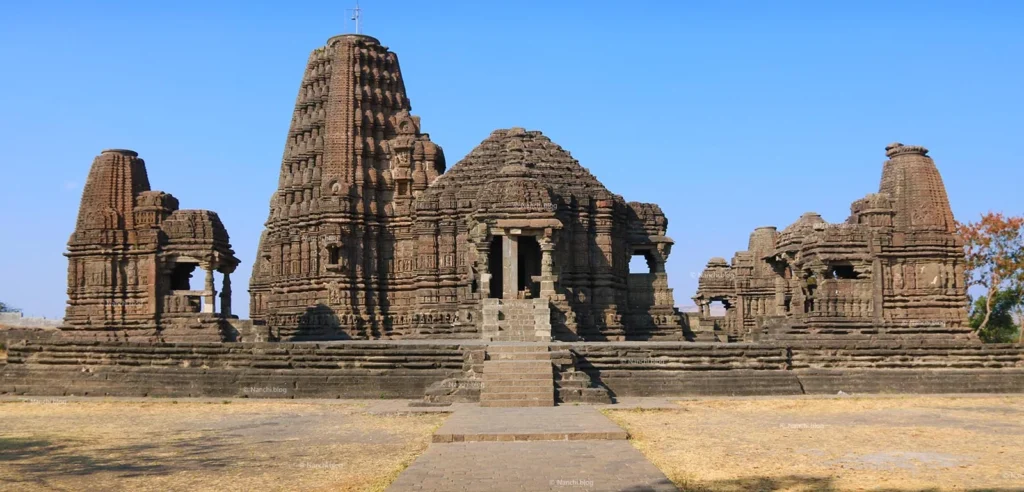
Legends and Myths of Gondeshwar Temple
One of the things that makes ancient temples in India endlessly fascinating is not just their architecture or history, but the stories whispered around them. Every old stone seems to carry a tale, every carving hides a deeper meaning. The Gondeshwar Temple in Sinnar is no different. Though historians can trace its construction to the Yadava dynasty, the myths and legends surrounding it are what keep the temple alive in the imagination of devotees and locals alike.
The Name Gondeshwar: A Guardian of the People
The very name “Gondeshwar” sparks curiosity. While the temple is dedicated to Lord Shiva, many believe the title “Gondeshwar” connects to the local Gond tribe, who once inhabited parts of this region. According to oral traditions, the Gonds revered Shiva as their protector, and the temple may have been seen as a guardian shrine for the community. Over time, the deity came to be affectionately called Gondeshwar—the Shiva who watches over the land and its people.
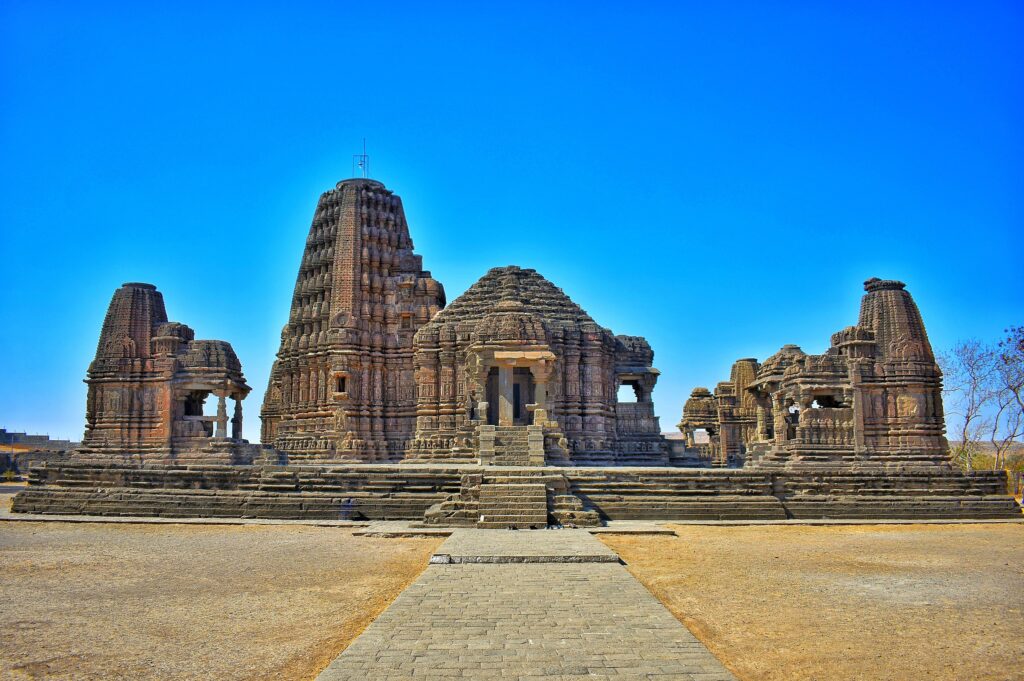
The Myth of Creation
Local lore says that the Gondeshwar Temple wasn’t built by human hands at all. Instead, it was believed to have emerged overnight from the earth itself, a manifestation of Shiva’s will. Some villagers still tell stories of how farmers, centuries ago, woke up to find a grand stone temple where there had only been a barren field the previous day.
This tale might sound like fantasy, but when you stand before the intricately carved basalt temple, it’s easy to see why people believed no ordinary mortal could have created something so perfect without divine intervention.
Connection to Shiva’s Cosmic Dance
Many of the carvings around the temple depict scenes of gods, demons, and celestial beings. One particularly striking interpretation is that the temple itself represents a stage for Shiva’s Tandava—the cosmic dance of creation and destruction. The soaring shikhara symbolizes Mount Kailash, while the mandapa (hall) is said to represent the earth where devotees witness the dance.
According to this myth, whenever devotees gather here during Shivratri and chant the Mahamrityunjaya Mantra, they are, in essence, recreating the cosmic balance that Shiva maintains through his dance.
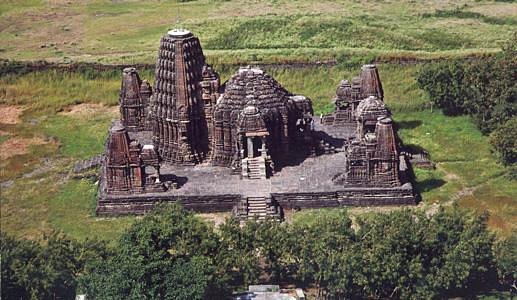
The Cursed King of Sinnar
One of the more dramatic legends tied to the Gondeshwar Temple involves a local king of Sinnar. Stories suggest that this king, though powerful, was arrogant and dismissive of the divine. To humble him, Shiva appeared in a dream and demanded that the king construct a temple worthy of the gods. The king initially ignored the command, but soon his kingdom suffered a terrible drought.
Desperate to save his people, the king finally commissioned the temple. Yet, by the time it was completed, he died suddenly—his pride undone, but his devotion redeemed. Locals say his spirit still roams near the temple, protecting it as penance. Even today, some elders warn children not to linger too long near the temple at night, lest they hear the king’s footsteps echoing in the stones.
Whispers of the Nandi
A fascinating feature at Gondeshwar Temple is the massive Nandi bull seated in front of the main shrine. While Nandi is a common feature in Shiva temples, here the statue has its own legend.
It is said that this Nandi was once alive. During a great invasion, when enemies attempted to destroy the temple, Nandi shook the ground with his hooves and let out a thunderous roar, scaring the invaders away. Locals believe that if you listen closely during quiet afternoons, you can hear faint rumblings under the earth—the lingering echo of Nandi’s protective power.
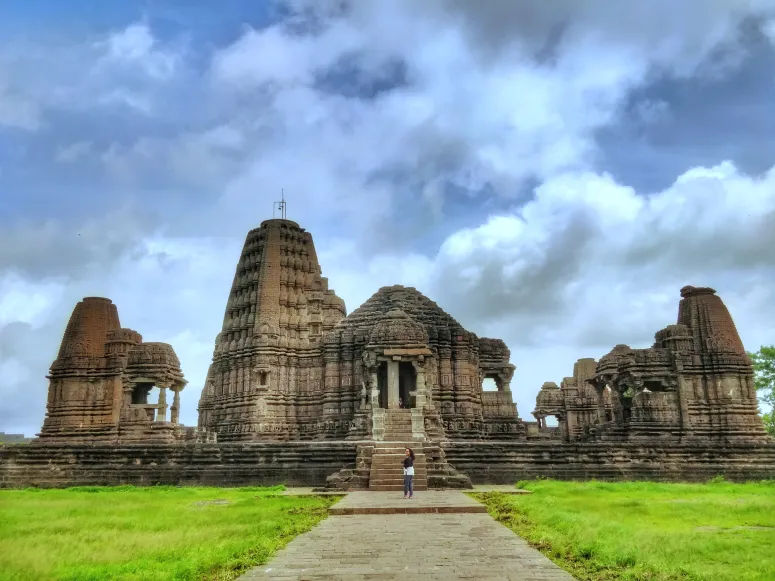
The River Godavari’s Blessing
Though the Gondeshwar Temple is not directly on the banks of the Godavari River, locals claim a mystical connection between the two. A legend tells that when the temple was consecrated, a channel of the Godavari miraculously diverted underground to bathe the lingam. Even today, the sanctum remains cool, and some devotees insist this is proof of the river’s blessing flowing beneath the structure.
Folklore Around Maha Shivratri
During Maha Shivratri, the Gondeshwar Temple becomes more than a place of worship—it transforms into a stage for age-old traditions. Villagers share stories that on this night, Shiva himself visits the temple in the form of a radiant light that circles the shikhara three times before disappearing into the sky.
Many devotees stay awake all night, hoping to catch a glimpse of this divine light. Whether or not one sees it, the sheer energy of the crowd chanting “Har Har Mahadev” under the starry sky is enough to make you believe that myths have a way of becoming real in moments like these.
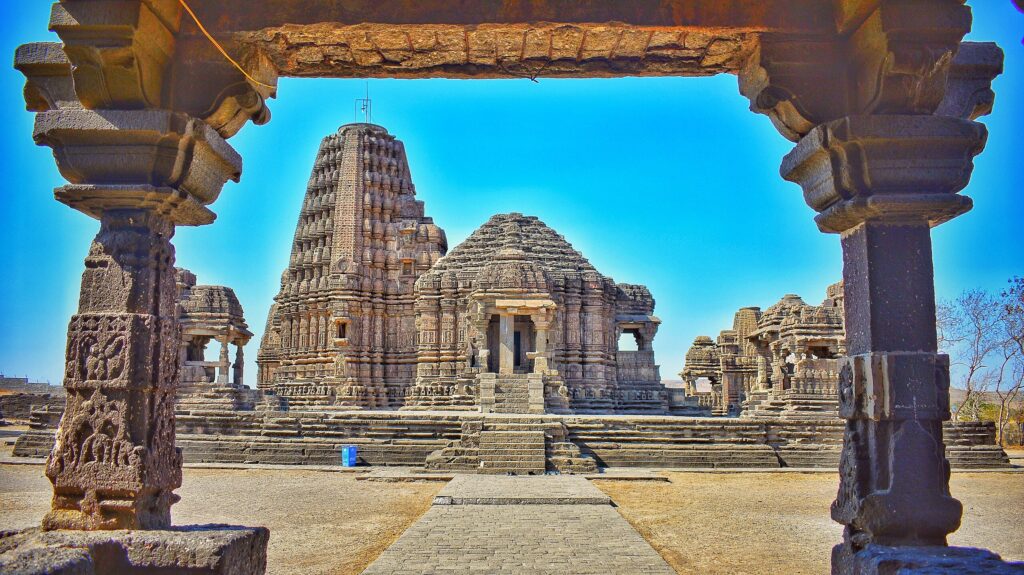
A Temple That Changes With Time
One of the more poetic legends about Gondeshwar is that it changes slightly every century. Elders say that if you compared the temple a hundred years ago to how it looks today, you’d notice small differences in carvings and stones. This leads some to believe that the temple is alive, breathing and evolving with the devotion it receives.
While historians would explain this as natural weathering or restoration, devotees like to think the temple is Shiva’s living abode, subtly reshaping itself as the ages roll by.
Architectural Grandeur
If you’re even remotely interested in architecture, Gondeshwar Temple is a masterpiece worth studying.
The Central Shrine
The main sanctum houses a Shiva Lingam. The shikhara above rises in tiers, each level adorned with miniature shrines, figures, and motifs. From a distance, the tower looks like a mountain carved by hand—intricate yet monumental.
The Mandapa
Before you reach the sanctum, you pass through a spacious mandapa (hall) supported by beautifully carved pillars. Light streams in through latticed stone windows, creating patterns on the floor. The acoustics are so perfect that even a whisper echoes softly, which must have added to the spiritual experience of chanting and singing bhajans here.
The Subsidiary Shrines
Around the central Shiva temple are four smaller shrines, believed to be dedicated to Vishnu, Brahma, Parvati, and Ganesha. Together, they represent the balance of divine powers. Walking around these shrines feels like moving through a miniature cosmos carved in stone.
Carvings and Sculptures
Every inch of the temple seems to have been touched by a sculptor’s chisel. Look closely and you’ll see:
- Scenes from Hindu epics like the Ramayana and Mahabharata.
- Celestial dancers (apsaras) frozen mid-movement.
- Elephants, lions, and mythical creatures guarding the walls.
- Delicate floral and geometric patterns framing doorways.
The longer you look, the more you find. It’s easy to lose track of time as your eyes travel from one sculpture to another.
Spiritual Experience
Though Gondeshwar Temple is an architectural marvel, it is not just a monument. It is still a functioning place of worship. Step inside the sanctum during puja hours, and the atmosphere comes alive with the ringing of bells, the fragrance of incense, and chants echoing through the stone hall.
Unlike crowded urban temples, here you have space to breathe, reflect, and truly connect with the divine. Many visitors I met spoke of the tranquility they felt inside—like the temple itself exudes calmness after centuries of silent meditation.
Things to Do at Gondeshwar Temple
- Explore the Carvings – Give yourself time to walk around slowly, noticing the details that often escape a quick glance.
- Photography – Morning and late afternoon light bring out the textures of the black stone beautifully. If you’re into photography, this place is a treasure trove.
- Meditation – Find a quiet corner of the mandapa, sit cross-legged, and let the stillness of the place settle in.
- Sketching or Journaling – Many travelers carry sketchbooks to capture the temple’s geometry. Even writing down your impressions feels more meaningful in that setting.
- Local Interaction – Speak with the locals in Sinnar. Many have grown up around the temple and share fascinating anecdotes about its legends.
How to Reach Gondeshwar Temple
- From Nashik: Sinnar is about 30 km and easily accessible by road. You can hire a taxi or take a bus.
- From Mumbai/Pune: Drive via the Mumbai–Nashik highway; Sinnar is a convenient stop if you’re headed toward Shirdi.
- Nearby Airport/Railway: The closest airport is Nashik Ozar Airport, while Nashik Road railway station is the nearest major railhead.
Best Time to Visit
- October to March: Pleasant weather, ideal for exploring the temple complex without the scorching heat.
- Monsoon (June–September): The surrounding landscape turns lush green, making the black stone temple stand out dramatically.
- Festivals: Visiting during Maha Shivratri gives you a chance to see the temple decorated with lights and filled with devotional energy.
Practical Tips
- Wear comfortable shoes—you’ll spend time walking on uneven stone floors.
- Carry water, especially in summer, as the sun can be harsh.
- Respect the sanctity of the place—avoid loud conversations or inappropriate clothing.
- Photography is usually allowed, but always check with the priest before clicking inside sanctum areas.
Beyond the Temple
If you have extra time, combine your trip with nearby attractions:
- Sinnar Town – Wander through the local markets, sampling traditional Maharashtrian snacks.
- Nashik Vineyards – Sula and other vineyards are just an hour away, offering tours and tastings.
- Shirdi – The famous Sai Baba temple is about 60 km from Sinnar, making it easy to plan a combined pilgrimage.
A Traveler’s Guide to Experiencing Gondeshwar Temple Spiritually
Most people come to Gondeshwar Temple in Sinnar with a simple plan: admire the architecture, click some photos, and maybe light a diya before leaving. And sure, those are all wonderful ways to enjoy it. But Gondeshwar isn’t just another heritage monument—it’s a living spiritual space, a place where you can slow down, tune in, and feel something far beyond the surface.
If you’re looking to move past being just a tourist and instead experience Gondeshwar Temple as a seeker, here’s a guide to help you immerse yourself in its spiritual essence.
Arrive with Intention
The first step is to arrive consciously. Don’t rush in like you’re checking off a sightseeing stop. Take a moment at the entrance to pause, breathe deeply, and set an intention for your visit. Whether you’re seeking peace, clarity, or simply gratitude, silently hold that thought in your heart.
It might sound small, but this shift in mindset changes the way the temple unfolds for you. The air feels heavier, the silence more meaningful, and even the carvings seem to whisper differently when you arrive with presence.
Start with a Circumambulation
As in many temples, it’s customary to walk around the shrine in a parikrama (circumambulation). At Gondeshwar, this isn’t just a ritual—it’s a chance to notice the carvings, the symmetry, and the way light plays on the stone.
Walk slowly, clockwise, keeping the sanctum on your right. With each step, let yourself become more grounded. Some devotees even count their steps, silently repeating “Om Namah Shivaya” with each one. You’ll be surprised at how calming this can feel, especially when the temple is quiet.
Spend Time with Nandi
In front of the sanctum sits the great Nandi bull, Shiva’s devoted gatekeeper. Many visitors simply bow quickly and move on, but if you linger here, something interesting happens.
Sit down in front of Nandi, align yourself so that you can see the Shiva Lingam inside the sanctum through the doorway. This alignment is symbolic—it’s said that Nandi never takes his eyes off Shiva, and sitting in his line of sight connects you directly to that devotion.
Spend a few minutes here in silence. Even without chanting or praying, you’ll feel a sense of focus and steadiness.
Listen to the Silence
One of Gondeshwar Temple’s underrated spiritual gifts is its acoustics. The thick basalt walls block out much of the outside noise, creating a natural hush. If you sit inside the mandapa (pillared hall) and close your eyes, you can actually hear the temple breathe—small sounds, distant birds, the occasional footsteps on stone.
Use this as an opportunity for silent meditation. You don’t have to be an expert meditator; just close your eyes, straighten your spine, and breathe deeply. Let the silence do its work. Even 10 minutes here can leave you feeling lighter.
Chant or Hum Softly
The temple’s design was made for sound. Even a soft hum echoes beautifully in the mandapa. Try chanting a simple mantra like “Om Namah Shivaya” softly under your breath.
Don’t worry about doing it “right.” The point is not performance—it’s resonance. Feel the vibration in your chest, notice how it bounces off the stone pillars, and imagine those sound waves traveling through the centuries of devotion embedded in the temple.
It’s a simple practice, but it makes you feel like you’re part of an unbroken chain of worshippers who have chanted here for nearly a thousand years.
Observe the Details as Meditation
For some people, sitting still is hard. If that’s you, try a more active form of meditation: observing the carvings. Pick one wall or one pillar, and study it intently. Notice the figures, the expressions, the way each curve is etched into stone.
The act of focusing fully on these details—without rushing—slows down the mind. You begin to notice the skill, patience, and devotion of the artisans, and in that awareness, you touch the spiritual dimension of the temple itself.
Participate in Rituals Respectfully
If you happen to visit during aarti (prayer rituals), don’t stand back like a detached observer. Step in respectfully, fold your hands, and allow yourself to be part of the rhythm—whether it’s the ringing of bells, the circling of lamps, or the offering of flowers.
Even if you don’t consider yourself religious, rituals have a way of drawing you into collective energy. You feel part of something larger, a gathering of human devotion that transcends time.
Try Early Morning or Twilight Visits
Timing can change your experience dramatically.
- Early morning: The temple feels serene, the air is crisp, and the rising sun bathes the black basalt in a golden glow. Few visitors are around, making it ideal for meditation.
- Twilight (Sandhya): As the sky shifts colors and lamps are lit inside the sanctum, the temple feels otherworldly. The contrast of flickering flames against ancient stone can stir deep emotions.
If you want the most spiritual experience, avoid the midday crowds and aim for these quieter windows.
Journal Your Reflections
Carry a small notebook with you. After sitting in silence or walking around the temple, jot down whatever comes to mind—thoughts, feelings, even random observations. This isn’t about creating a perfect travelogue; it’s about processing your experience.
Later, when you look back at those notes, you’ll realize how the temple touched you in subtle ways you may not have noticed at first.
Respect the Energy of the Place
One of the best ways to have a spiritual experience is also the simplest: be respectful. Lower your voice, switch off loud notifications, dress modestly, and treat the space as sacred.
Temples like Gondeshwar hold centuries of accumulated energy. When you respect that, the space opens up to you in return.
Why Gondeshwar Temple Stays With You
What makes Gondeshwar Temple unforgettable isn’t just its age or artistry. It’s the way it combines history, devotion, and tranquility in one space. Here is a temple that has stood quietly for nearly a millennium, weathering time yet still offering a place for prayer and reflection.
Walking away from Gondeshwar, I felt a deep sense of gratitude—not just for the chance to see such beauty, but for the generations who built and preserved it. It reminds you that faith isn’t only about rituals; it’s also about creating something enduring, something that continues to inspire centuries later.
So if you ever find yourself in Nashik or on the way to Shirdi, take that small detour to Sinnar. Spend an hour—or better yet, a day—at Gondeshwar Temple. You won’t just see a monument; you’ll step into a world where art, spirituality, and history meet in stone.
FAQs
Q1. Where is Gondeshwar Temple located?
It is located in Sinnar town, about 30 km from Nashik, Maharashtra.
Q2. Who built the Gondeshwar Temple?
The temple was constructed in the 12th century during the Yadava dynasty rule.
Q3. Which deity is worshipped at Gondeshwar Temple?
The temple is dedicated to Lord Shiva, enshrined as a grand Shiva Linga.
Q4. What is special about the temple’s architecture?
It is built in the Hemadpanthi style, using black basalt stone without mortar, showcasing detailed sculptures.
Q5. Are there other shrines inside the complex?
Yes, the complex has smaller temples dedicated to Vishnu, Ganesha, Parvati, and Surya.
Q6. Why is Gondeshwar Temple famous?
It is the largest surviving Hemadpanthi-style temple in Maharashtra, known for its artistic beauty.
Q7. What are the temple timings?
The temple is generally open from morning to evening for devotees and visitors.
Q8. Is there any entry fee?
No, the temple is free to enter for all visitors.
Q9. How can one reach Gondeshwar Temple?
It is well connected by road from Nashik and Pune; the nearest railway station is Nashik Road.
Q10. What is the best time to visit Gondeshwar Temple?
October to March is ideal for exploring the temple in pleasant weather.


